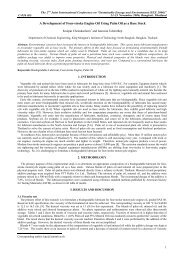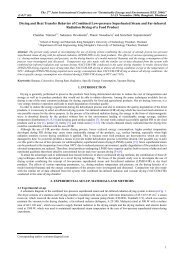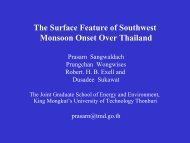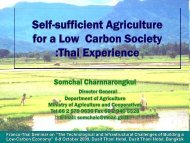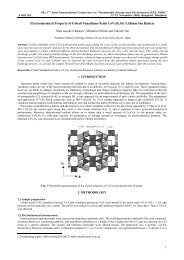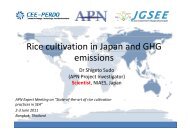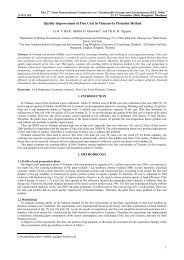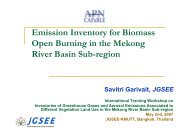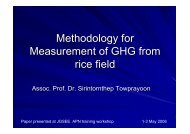Anaerobic Co-Digestion of Cassava Pulp and Pig Manure: Effects of ...
Anaerobic Co-Digestion of Cassava Pulp and Pig Manure: Effects of ...
Anaerobic Co-Digestion of Cassava Pulp and Pig Manure: Effects of ...
- No tags were found...
Create successful ePaper yourself
Turn your PDF publications into a flip-book with our unique Google optimized e-Paper software.
<strong>Anaerobic</strong> <strong>Co</strong>-<strong>Digestion</strong> <strong>of</strong><strong>Cassava</strong> <strong>Pulp</strong> <strong>and</strong> <strong>Pig</strong> <strong>Manure</strong>:<strong>Effects</strong> <strong>of</strong> Waste Ratio <strong>and</strong>Inoculum-Substrate RatioPornpan Panichnumsin, Annop Nopharatana,Birgitte Ahring <strong>and</strong> Pawinee Chaiprasert
Why? <strong>Anaerobic</strong> <strong>Co</strong>-<strong>Digestion</strong>• Treatment <strong>of</strong> at least two waste types• Help improvement– methane yield– process stability• Economically more favorable system• Share common facility <strong>of</strong> different wastestreams• Successful application to several type<strong>of</strong> agricultural <strong>and</strong> industrial wastes
Background: Potential wastes<strong>Cassava</strong> <strong>Pulp</strong>• 3.5 Million tons generated annually• <strong>Co</strong>ntributes to environmental impacts;methane emission, soil <strong>and</strong> ground-watercontamination by leachate, odour problem• <strong>Co</strong>mprises <strong>of</strong> 56% starch, 5.3% proteins,0.1% lipids, 2.7% ash <strong>and</strong> 35.9% fiber• Potential substrate for biogas production
Background<strong>Pig</strong> <strong>Manure</strong>• generated approximately 2 billions kg drymatter/year• <strong>Co</strong>mprises <strong>of</strong> 52% carbohydrate, 23% proteins,13% lipids, 7% VFA <strong>and</strong> 5% lignin• could contribute to future renewable energy(biogas) up to about 2,828 TJ/year
CO-DIGESTION OF CASSAVA PULPWITH PIG MANURECASSAVA PULP• Carbohydrate - rich• High C/N ratio• Low alkalinity• Lack <strong>of</strong> macro/micronutrientsPIG MANURE• Low C/N ratio• High alkalinity• Rich in macro/micronutrientsImprove C/N ratio, buffering capacity<strong>and</strong> more biodegradable substrateHigh process stability <strong>and</strong> better biodegradability<strong>and</strong> methane yield
Objective• To study effect <strong>of</strong> waste ratio <strong>and</strong> inoculumsubstrateratio (ISR) on anaerobic co-digestion <strong>of</strong>cassava pulp <strong>and</strong> pig manure<strong>Cassava</strong> pulp<strong>Pig</strong> manureCharacterization<strong>Co</strong>-digestionISRWaste ratioMethane production rateLag phase periodMethane production potentialMethodology & AnalysisEvaluation
Experimental Set-up• Substrates:• cassava pulp from cassava starch factory• pig manure from medium scale pig farm• Inoculum: digested pig manure taken fromanaerobic plug flow reactor• Batch experiment: using serum vial techniquegVS <strong>of</strong> Inoculum ( Fixed)ISR == 0.5,1.0,1.5gVS <strong>of</strong> Substrate ( Varied)<strong>Cassava</strong> pulpWaste Ratio = % = C : M Ratio<strong>Pig</strong> manure• C:M Ratios = 0:100, 20:80, 40:60, 50:50, 60:40, 80:20 &100:0based on VS conc.
AnalysisParameters Methods ReferencesBiogas Displacement method APHA, 1995productionBiogascomposition(CH 4 , CO 2 , Air)GC-TCD Shimudzu GC-9A,column SUS, porapack NTS Dried at 105°C APHA, 1995VS TS loss after ignited at 550°Cfor 3 hr.pHElectrometric method, pHmeterVFA GC-FID Shimudzu GC- 14B,column carbowax B-DAAPHA, 1995APHA, 1995
Evaluation• Ultimate methane production• Modified Gompertz equation:Rm × eM = P × exp{ − exp[ ( λ − t)+ 1]}P• Rm = Max. specific methane production rate(mlCH4/gVS-inoculum.d)• λ = Lag phase time (day)• P = Methane potential (ml)• SOLVER tool <strong>of</strong> Excel TM
Results & DiscussionUltimate methane yield(ml/g VSadded)4003503002502001501005000 0.5 1 1.5ISR0:100 20:80 40:60 50:50 60:40 80:20 100:0ISR C:M Max.Yield0.5 0:100 3931 50:50 3671.5 100:0 318Both ISR <strong>and</strong> wasteratio have strongeffect on methaneyieldUltimate methane yield vs ISR <strong>and</strong> waste ratio
Pattern <strong>of</strong> accumulative methane production(A) ISR-1.5(B ) IS R -1100200Methane (ml)50Methane (ml)1501005000 50 100Time (day)Methane (ml)400350300250200150100500(C ) IS R -0 .50 5 0 1 0 0Tim e (day)00 50 100Time (day)0:100, •20:80,40:60,50:50,60:40, •80:20<strong>and</strong> +100:0
<strong>Effects</strong> <strong>of</strong> ISR & waste ratio on calculated Rm, λ <strong>and</strong> PC:MRatio0:100Rm (ml/gVS.day) λ (days) P (ml)ISR-0.559ISR-119ISR-1.58ISR-0.50ISR-10ISR-1.50ISR-0.5355ISR-1165ISR-1.56620:805023120003501766540:60 17 25 14 4.56 0 0376 180 6550:5014261710.94004161836860:4012131930.09004381706680:20-1126-8.250-18071100:0 -933-38.560- 17181λ occurred at low ISR <strong>and</strong> high %<strong>Cassava</strong>P increased with increasing ISR <strong>and</strong> % <strong>Cassava</strong>
Accumulation <strong>of</strong> high VFA at low pH inhibited themethanogenesis at low ISR <strong>and</strong> high %<strong>Cassava</strong>50008Total VFA(mg/l as acetic acid)450040003500300025002000150010005007654321pH valueVFA-ISR-0.5VFA-ISR-1VFA-ISR-1.5pH-ISR-0.5pH-ISR-1pH-ISR-1.5000:10020:8040:6050:5060:4080:20100:0C:M RatiosTotal VFA <strong>and</strong> pH values at day 7th
Methanogenesis was inhibited when high conc. <strong>of</strong>AA, PA <strong>and</strong> BA accumulatedC:MratiosAcetic acid Propionic acid n-Butyric acidISR0.5ISR1ISR0.5ISR1ISR0.5ISR10:100 0 0 0 0 21 020:80 0 0 63 0 68 040:60 38 0 1568 0 814 050:50 1662 0 1412 0 1106 060:40 1730 110 1567 318 1238 10480:20 2082 1925 2112 215 1469 1168100:0 2429 2017 1539 84 2103 1768
<strong>Co</strong>nclusions• Both ISR <strong>and</strong> waste ratio directly have stronginfluence on co-digestion <strong>of</strong> cassava pulp <strong>and</strong>pig manure in terms <strong>of</strong> methane production rate,methane yield <strong>and</strong> process stability.• <strong>Co</strong>-digesting the two wastes has been provedbeneficial in this study.• The examined ISR <strong>and</strong> waste ratio could beused to specify appropriate substrate input <strong>and</strong>inoculum concentrations for further optimizationin order to maximize methane production <strong>and</strong>avoid acid inhibition during a start-up period.
Acknowledgement• The Joint Graduate School <strong>of</strong> Energy <strong>and</strong>Environment• The Royal Jubilee Ph.D Program• National Research <strong>Co</strong>uncil <strong>of</strong> Thail<strong>and</strong>• Nunsurakit’s Tapioca Flour Ltd., Part•K P Farm• Excellent Center <strong>of</strong> Waste Utilization <strong>and</strong>Management (E<strong>Co</strong> Waste) at KMUTT
Thank you for your attention
Waste Characteristics<strong>Co</strong>mpositional analysis <strong>of</strong> fresh cassava pulp <strong>and</strong> pig manure<strong>Co</strong>mposition Unit <strong>Cassava</strong> pulp <strong>Pig</strong> manureTS g kg -1 fresh waste 305±2 253±4VS g kg -1 TS 984±1 716±10Ash g kg -1 TS 16±1 284±10TKN g kg -1 TS 1.7±0.0 31.7±0.8NH 4+-N g kg -1 TS n.d. 4.5±0.5COD g kg -1 VS 1050±50 1400±200Starch g kg -1 VS 655.1±4.7 n.d.Crude fiber g kg -1 VS 312±3 312±5Protein g kg -1 VS 10.8±0.3 276.8±4.5Values are the mean ± S.D. <strong>of</strong> 3 determinations, n.d. = not determine
Methodology10 ml Distilled water20 ml Substrate15 mlDigested pig manureCO 2 /N 2 (30:70%)120 ml Vial 120 ml VialSampleWorking vol. 45 mlIncubated at 37°Cfor 120 days<strong>Co</strong>ntrol
C:MRatiosRm (ml/gVS.day)ISR-0.5 ISR-1 ISR-1.50:1005919820:8050231240:6017251450:5014261760:4012131980:20-1126100:0-933
λ occurred at low ISR <strong>and</strong> high %<strong>Cassava</strong>P increased with increasing ISR <strong>and</strong> % <strong>Cassava</strong>C:MRatiosλ (days)P (ml)ISR-0.5 ISR-1 ISR-1.5 ISR-0.5 ISR-1 ISR-1.50:100 0 0 0 355 165 6620:80 0 0 0 350 176 6540:60 4.56 0 0 376 180 6550:50 10.94 0 0 416 183 6860:40 30.09 0 0 438 170 6680:20 - 8.25 0 - 180 71100:0 - 38.56 0 - 171 81
Maximum specificmethane production rate(mlCH4/g VS.d)60504030201000:100 20:80 40:60 50:50 60:40 80:20 100:0C:M Ratios0.5 1 1.5Max. methane production rate <strong>of</strong> different wasteratios at ISR 0.5, 1, 1.5
Evaluation• Ultimate methane production• Modified Gompertz equation:MRm × e= P × exp{ − exp[ ( λ − t)+ 1]}P• Max. specific methane production rate (Rm)• Lag phase time (λ)• Methane potential (P)• SOLVER tool <strong>of</strong> Excel TM• Effluent characteristics after 120 days <strong>of</strong>digestion
9080706050403020100Effluent characteristics after 120 days <strong>of</strong> digestion(A) VS0:10020:8040:6050:5060:4080:20100:0C:M RatiosISR-0.5ISR-1ISR-1.59080706050403020100(B) Total COD0:10020:8040:6050:5060:4080:20100:0C:M RatiosISR-0.5ISR-1ISR-1.5VS Reduction (%)Total COD Reduction (%)(C) Soluble COD1086420ISR-0.5ISR-1ISR-1.5Soluble COD<strong>Co</strong>ncentration (g/l)0:10020:8040:6050:5060:4080:20100:0C:M Ratios
Methanogenesis was inhibited when high conc. <strong>of</strong>AA, PA <strong>and</strong> BA accumulated300025002000150010005000(A) ISR-1Specific VFA<strong>Co</strong>ncentration (mg/l)0:10020:8040:6050:5060:4080:20100:0C:M Ratios300025002000150010005000(B) ISR-0.5Specific VFA <strong>Co</strong>ncentration(mg/l)0:10020:8040:6050:5060:4080:20100:0C:M RatiosAcetic acid Propionic acid Butyric acidAcetic acid Propionic acid Butyric acidSpecific VFAs at day 7 th
Many investigations reported high conc. <strong>of</strong> VFA(AA, PA, BA) are associated with inhibitory effectGebauer <strong>and</strong> Eikebrokk (2006): The retardation <strong>of</strong> anaerobic processwas due to high concentration <strong>of</strong> acetate.Ahring <strong>and</strong> Westermann (1988): Acetate accumulation inhibiteddegradation <strong>of</strong> propionate <strong>and</strong> butyrate.Raposo et al. (2006):The degradation <strong>of</strong> longer chain VFAs was inhibitedwhen the acetic acid concentration was greater than 1600 mg/l.Kaspar <strong>and</strong> Wuhrmann (1978): propionic acid inhibited the methaneformation.Mechichi <strong>and</strong> Sayadi (2005) : Butyrate, isobutyrate <strong>and</strong> valerateaccumulated when acetate <strong>and</strong> propionate concentration reached highconcentration.



